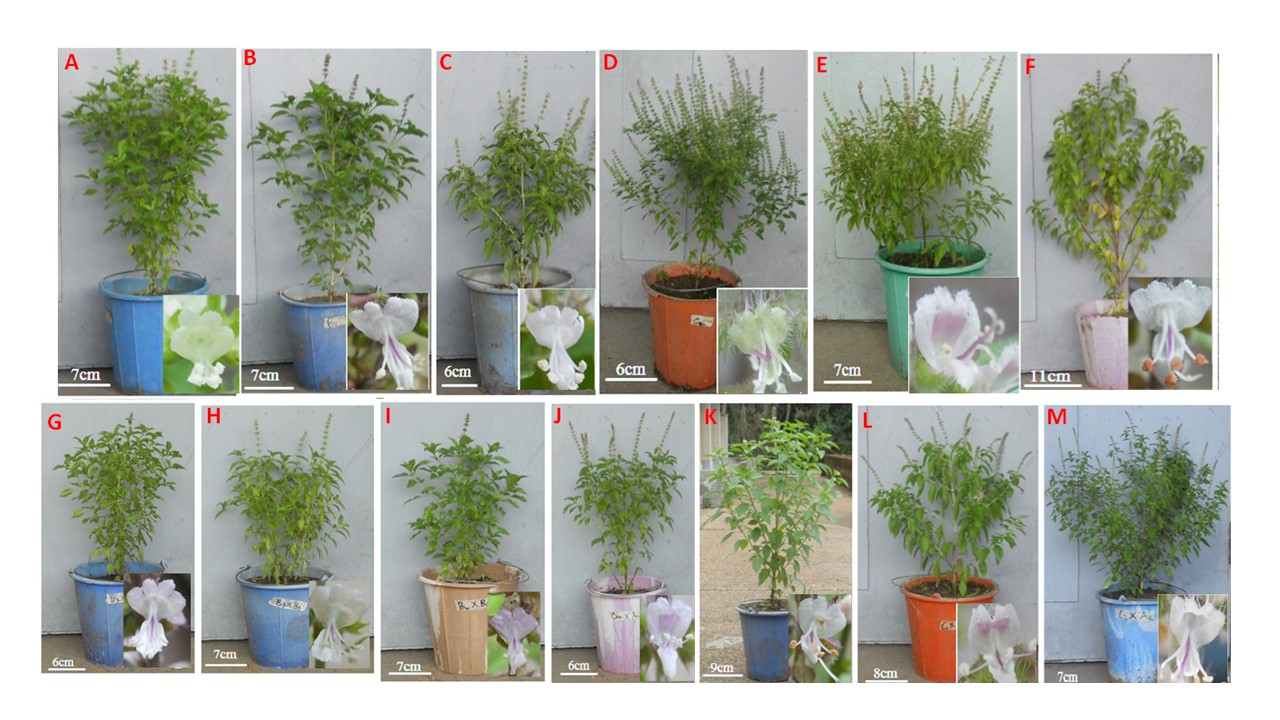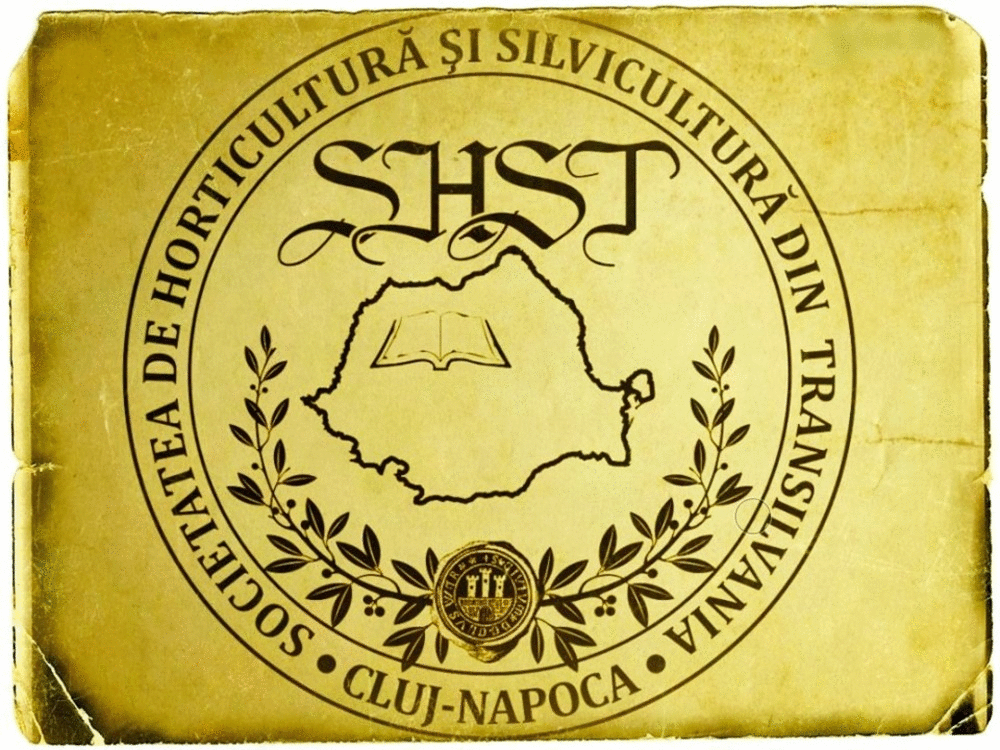Polyploidization and speciation: patterns of natural hybridization and gene flow in basil (Ocimum spp.)
DOI:
https://doi.org/10.55779/nsb14311289Keywords:
hybrid, hybridization, Ocimum, polyploidy, speciationAbstract
The genus Ocimum maintains rich diversity of species through natural and artificial outcrossing. Africa is named as one of the epicentres of plant diversity including numerous Ocimum species. Cytological evidence has attributed such diversity to extensive genome augmentation through selection, speciation, polyploidy and hybridization. This study identified polyploidy as the major natural phenomenon that drives successful hybridization programs or otherwise, within and among four Ocimum species studied and showed rate of gene exchange among the concerned species. All Ocimum species and variants used were grown for two generations before hybridization experiments were carried out. Interspecific and intraspecific reciprocal crossing was done. The crossed flowers were monitored for flower abortion and fruit formation. The resulting progenies from successful crosses were raised along with their parents and evaluated for all identifiable agronomic character differences and similarities. All viable seeds resulted from crosses involving at least one polyploid parent (tetraploids O. basilicum, O. canum and O. americanum). The intra- and interspecific hybridization programs recorded success within O. basilicum and between O. basilicum and tetraploid O. canum. Hybridization within O. canum was difficult due to differences in ploidy levels of O. canum parents used. Hybrid progenies obtained within O. basilicum parents (b1 and b2) and between b2 and tetraploid O. canum possessed morphological characters related to b2 parent while offspring from crosses between b1 and c1 combined characters from both parents. Pollen fertility in both O. basilicum and O. canum parents and their reciprocal crosses was more than 50 percent. O. basilicum displayed higher gene exchange capacity than other species. O. kilimandscharicum and O. americanum parents exhibited allopatric behaviour and low crossability with other seemingly sympatric species used in the study. Genome imbalance and incompatibility were associated with some of the possible causes of sterility.
Metrics
References
Alix K, Gérard PR, Schwarzacher T, Heslop-Harrison JSP (2017). Polyploidy and interspecific hybridization: Partners for adaptation, speciation and evolution in plants. Annals of Botany 120(2):183-194. https://doi.org/10.1093/aob/mcx079
Burkill H (1995). The useful plants of West Tropical Africa. 2nd ed. Kew: Royal Botanic Gardens 3:19-27.
Chowdhury T, Mandal A, Roy SC, De Sarker D (2017). Diversity of the genus Ocimum (Lamiaceae) through morpho-molecular (RAPD) and chemical (GC–MS) analysis. Journal of Genetic Engineering and Biotechnology 15(1):275-286. https://doi.org/10.1016/j.jgeb.2016.12.004
Coyne, J. A., & Orr, H. A. (2004). SPECIATION. Sinauer Associates, Inc.
Ene CO, Ogbonna PE, Agbo CU, Chukwudi UP (2016). Studies of phenotypic and genotypic variation in sixteen cucumber genotypes. Chilean Journal of Agricultural Research 76(3):307-313. https://doi.org/10.4067/S0718-58392016000300007
Gaebelein R, Schiessl SV, Samans B, Batley J, Mason AS (2019). Inherited allelic variants and novel karyotype changes influence fertility and genome stability in Brassica allohexaploids. New Phytologist 223:965-978. https://doi.org/10.1111/nph.15804
Hasegawa Y, Tajima K, Toi N, Sugimura Y (1997). Characteristic components found in the essential oil of Ocimum basilicum L. Flavour and Fragrance Journal 12(3):195-200. https://doi.org/10.1002/(SICI)1099-1026(199705)12:3<195::AID-FFJ632>3.0.CO;2-O
Idowu JA, Oziegbe M (2017). Mitotic and meiotic studies on two species of Ocimum (Lamiaceae) and their F1 hybrids. Botanica Lithuanica 23(1):59-67. https://doi.org/10.1515/botlit-2017-0006
Katche E, Quezada-Martinez D, Katche EI, Vasquez-Teuber P, Mason AS (2019). Interspecific Hybridization for Brassica Crop Improvement. Crop Breeding, Genetics and Genomics 1:1-32. https://doi.org/10.20900/cbgg20190007
Khosla MK, Sobti SN (1985). Karyomorphological Studies in Genus Ocimum II. Sanctum Group. Cytologia 50(2):253-263. https://doi.org/10.1508/cytologia.50.253
Leitch AR, Leitch IJ (2008). Genomic plasticity and the diversity of polyploid plants. Science 320:481-483. https://doi.org/10.1111/j.1365-313X.2008.03432.x
Lloyd AH, Ranoux M, Vautrin S, Glover N, Fourment J, Charif D, . . . Jenczewski E (2014). Meiotic gene evolution: Can you teach a new dog new tricks? Molecular Biology and Evolution 31(7):1724-1727. https://doi.org/10.1093/molbev/msu119
Madlung A, Wendel JF (2013). Genetic and epigenetic aspects of polyploid evolution in plants. Cytogenetic and Genome Research 140(2-4):270-285. https://doi.org/10.1159/000351430
Mason AS, Batley J (2015). Creating new interspecific hybrid and polyploid crops. Trends in Biotechnology 1-6. https://doi.org/10.1016/j.tibtech.2015.06.004
Matthew JO, Oziegbe M (2016). Intraspecific and Interspecific of four Ocimum species. Nigeria Journal of Genetics 30:29-33.
Mayrose I, Zhan SH., Rothfels CJ, Magnuson-Ford K, Barker MS, Rieseberg LH, Otto SP (2011). Recently formed polyploid plants diversify at lower rates. Science 333(6047):1257. https://doi.org/10.1126/science.1207205
Mukherjee M, Datta AK (2006). Secondary chromosome associations in Ocimum spp. Cytologia 71(2):149-152. https://doi.org/10.1508/cytologia.71.149
Olorode O, Baquar SR (1976). The Hyparrhenia involucrata-H. subplumosa (Gramineae) complex in Nigeria: morphological and cytological characterization. Botanical Journal of the Linnean Society 72:212-222.
Oziegbe M, Kehinde TO, Matthew JO (2016). Comparative reproduction mechanisms of three species of Ocimum L. (Lamiaceae). Acta Agrobotanica 69(1):1-9. https://doi.org/10.5586/aa.1648
Palchetti E, Gori M, Biricolti S, Masoni A, Bini L, Tani C, Falsini S, (. . .) Papini A (2020). Possible hybrid speciation for two Malagasy species of piper l. (Piperaceae). Caryologia 73(4):27-38. https://doi.org/10.13128/caryologia-1133
Patel HK, Fougat RS, Kumar S, Mistry JG, Kumar M (2015). Detection of genetic variation in Ocimum species using RAPD and ISSR markers. 3 Biotech 5(5):697-707. https://doi.org/10.1007/s13205-014-0269-y
Paton A, Putievsky E (1996). Taxonomic problems and cytotaxonomic relationships between and within varieties of Ocimum basilicum and related species (Labiatae). Kew Bulletin 51(3):509-524. https://doi.org/10.2307/4117026
Peng CI, Schmidt CL, Hoch PC, Raven PH (2005). Systematics and evolution of Ludwigia section Dantia (Onagraceae). Missouri Botanical Garden Press 92:307-359. http://www.jstor.org/stable/40035477
Pushpangadan P, Bradu BL (1995). Medicinal and Aromatic Plants. In: Chaddha KL and Gupta R (Eds). Advances in Horticulture 11:627-657.
Pyne RM, Honig JA, Vaiciunas J, Wyenandt CA, Simon JE (2018). Population structure, genetic diversity and downy mildew resistance among Ocimum species germplasm. BMC Plant Biology 18(1):1-15. https://doi.org/10.1186/s12870-018-1284-7
Rao BRR, Kothari SK, Rajput DK, Patel RP, Darokar MP (2011). Chemical and biological diversity in fourteen selections of four Ocimum species. Natural Product Communications 6(11):1705-1710. https://doi.org/10.1177/1934578x1100601134
Rewers M, Jedrzejczyk I (2016). Genetic characterization of Ocimum genus using flow cytometry and inter-simple sequence repeat markers. Industrial Crops & Products 91:142-151. https://doi.org/10.1016/j.indcrop.2016.07.006
Sarwat M, Srivastava S, Naved T (2016). Diversity analyses in Ocimum species: Why and how? International Journal of Pharmacognosy and Phytochemical Research 8(2):252-262.
Shanaida M, Kernychna I, Shanaida, Y (2017). Chromatographic analysis of organic acids, amino acids, and sugars in Ocimum americanum L. Acta Poloniae Pharmaceutica - Drug Research 74(2):729-734.
Smitha GR, Tripathy V (2016). Seasonal variation in the essential oils extracted from leaves and inflorescence of different Ocimum species grown in Western plains of India. Industrial Crops and Products 94:52-64. https://doi.org/10.1016/j.indcrop.2016.07.041
Storme ND, Mason A (2014). Plant speciation through chromosome instability and ploidy change: Cellular mechanisms, molecular factors and evolutionary relevance. Current Plant Biology. https://doi.org/10.1016/j.cpb.2014.09.002
Vieira RF, Goldsbrough P, Simon JE (2003). Genetic Diversity of Basil (Ocimum spp.) Based on RAPD Markers. Journal of the American Society for Horticultural Science 128(1):94-99.
Viruel J, Conejero M, Hidalgo O, Pokorny L, Powell RF, Forest F, . . . Leitch IJ (2019). A target capture-based method to estimate ploidy from herbarium specimens. Frontiers in Plant Science 10. https://doi.org/10.3389/fpls.2019.00937

Downloads
Published
How to Cite
Issue
Section
License
Papers published in Notulae Scientia Biologicae are Open-Access, distributed under the terms and conditions of the Creative Commons Attribution License.
© Articles by the authors; licensee SMTCT, Cluj-Napoca, Romania. The journal allows the author(s) to hold the copyright/to retain publishing rights without restriction.
License:
Open Access Journal - the journal offers free, immediate, and unrestricted access to peer-reviewed research and scholarly work, due SMTCT supports to increase the visibility, accessibility and reputation of the researchers, regardless of geography and their budgets. Users are allowed to read, download, copy, distribute, print, search, or link to the full texts of the articles, or use them for any other lawful purpose, without asking prior permission from the publisher or the author.













.png)















